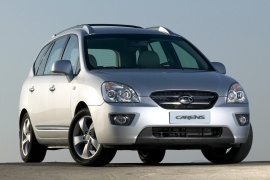
KIA Carens
Generations Timeline, Specs and Pictures

The MPVs were usually bought out of the necessity to transport more people or to fit more luggages and the design was not really a criteria.
However, through the years, their design improved as well and that increased the number of interested buyers. It was the same for the KIA Carens which was not only practical, but was also a good looker.
The 2016 Kia Carens was available with 4 trim levels, intuitively named 1,2,3 and 4. The 4 trim level offered a nice interior, equipped with soft plastics, perforated leather inserts for the doors, a 7-inch touchscreen for the infotainment system and a well-positioned control panel.
The Carens had large windows allowing lots of light to enter the cabin thus giving a pleasant feeling while driving besides the excellent visibility. The topping-range 4 trim level came with a panoramic sunroof, parking sensors and a rear-view camera, as well as a 7-speaker sound system as standard. The seats were wrapped up with leather and the front seats were very comfortable, which seems normal for a car being designed for long trips.
The second row of seats was actually made of 3 separate seats, each of them being adjustable. The 3rd row, although not very easy to access, ensured enough space for 2 people, thus allowing a maximum of 7 people in the car, driver included.
With the 3rd row seats unfolded, the trunk space was almost inexistent, however, folded seats offered lots of space for the luggages of 5 people.

Kia introduced the third generation of the Carens/Rondo in 2013 and made it more friendly with the environment by following the downsizing trend and dropping the V-6 engine.
The new generation replaced both the Sedona and the Carens and showed a styling that matched the rest of the Kia lineup. While the MPV segment was shrinking, there were still enough buyers to convince a few carmakers to build a small or compact-sized MPV in a world dominated by crossovers and SUVs.
At the front, the angular headlights swept-back to the sides resembled the ones found on the Kia cee’d. The entire car looked like an oversized cee’d, with a taller greenhouse. That led to a steep hood that tried to connect to the raked windshield. The taillights showed a similar shape to those installed on the compact hatchback cee’d in.
But most people are buying seven-seat vehicles for their interiors. In that aspect, the Kia significantly improved the Carens. It offered plenty of headroom and legroom for the front and middle-row passengers. Five people could sit inside without any worries, but those two flat-folding seats in the back were too cramped to be used for more than a five-minute drive.
Under the hood, Kia offered the Carens with a wide range of engines, depending on the market. While the Canadians loved the gasoline units, the Europeans and the U.K. buyers ticked the boxes for the turbo-diesel versions.

Kia introduced the second generation of the Carens MPV in 2006, but some specific markets received it only in 2008.
While the world financial crisis was evolving and crumbled empires, Kia was on the verge of getting more market share. After it successfully introduced the cee’d on the market, it pressed harder with other models, such as the Carens MPV.
Kia didn’t have a good design department when it started developing the Carens, but it tried to make it as appealing as possible. The result was more of an expanded station wagon than an MPV. Its front side appeared closer to a two-box design vehicle, such as an SUV or a hatchback. But the tall greenhouse confirmed the car’s minivan status.
Inside, the designers were inspired by American MPVs when they installed the gear-stick in the center stack, while most European carmakers placed that on the floor. The driver was surrounded in a cluster-like area, with a car-like instrument cluster and easy-to-reach controls. In the back, the carmaker offered five seats as standard and an option for seven, with two jump-seats in the trunk area.
Under the hood, depending on the market, KIA installed a choice of three engines. While most countries received the 2.0-l liter gasoline unit, the diesel version was not available everywhere, and that was the engine of choice for the British and European customers, thanks to its very good fuel-efficiency.

Kia introduced a facelifted version for the first generation of the Carens MPV in 2002 and improved the compact five-seat minivan.
In 2002, the Korean carmaker was still trying to make its way onto the European markets. It adopted the same strategy as Hyundai by introducing new or updated models faster than other carmakers. Thus, there was at least one new vehicle every year coming into its dealer network. While it wasn’t the most handsome car in the parking lot, the Carens proved to be a worthy vehicle for those who needed a roomy interior with a lot of luggage space and a high seating position behind the wheel.
The first Carens’ generation looked more like a taller compact-segment station wagon than a minivan, but it served the purpose. At the front, there was a new front fascia with improved headlights. They sported a triangular shape with a curved upper side and clear lenses. The upper side of the doors looked like Kia added it to a regular hatchback door panel. On the bright side, they featured flush door handles and mirrors in body color. Kia’s designers installed the third window between the rear doors and the thick D-pillars.
Inside, the carmaker improved the quality of the materials and offered leather upholstery on the upper trim levels as an option. The dashboard featured a Ford Focus-like instrument panel extended over the center stack, with a shield-like silver trim that adorned it.
Under the hood, Kia installed a wide choice of engines ranged between 105 hp and 138 hp. For fleet owners, the carmaker offered an option of two powerplants fueled with CNG.

Kia introduced the Carens on the market in 1999 as an important contender in the compact MPV segment and sold it as Rondo on specific markets.
By the 2000s, the Korean carmaker was no longer a small, inexperienced carmaker, and it dared to work harder and offer new alternatives for more than two segments. The Carens was also known as the Rondo on the U.S. market, but its main target was the European continent, where it fought against the respectable Renault Scenic and Citroen Xsara Picasso.
While its looks resembled an oversized station wagon hatchback, the customers couldn’t ignore its affordable price, which, in many situations, mattered more than its look. Its front area featured a short slated grille and a pair of headlights narrower on the inside. The corner-mounted turn-signals featured clear lenses with yellow bulbs. From its sides, the car revealed a very tall greenhouse that led to a big headroom for its passengers. The thick C-pillar was blamed for lowering the rear three-quarter visibility, while the masked D-pillars made the car looks like it had a wrapped-around rear window area over the tailgate.
Inside, the Carens/Rondo offered room for seven in a 2-3-2 configuration with limited legroom for the third row. Its sliding middle row made it possible for its occupants to enjoy a better room if nobody sat in the rearmost seats. With all the seats in place, there was virtually no trunk area left.
Kia offered the Carens with a four-engine choice, including a new 2.0-liter turbo-diesel version. For specific markets, it offered the car with CNG engines and automatic transmissions.























































